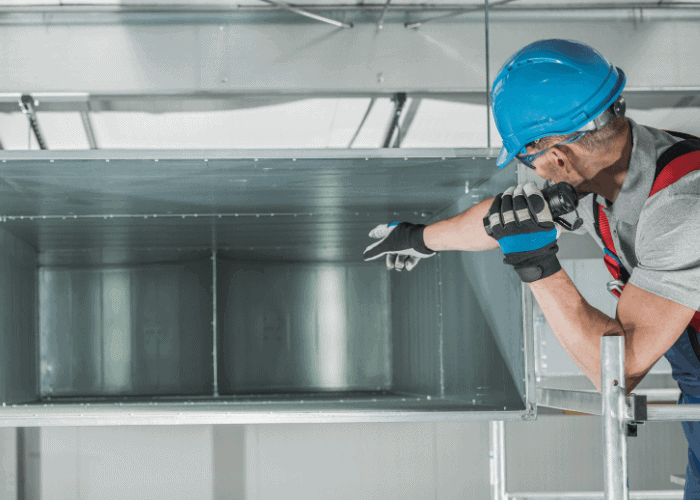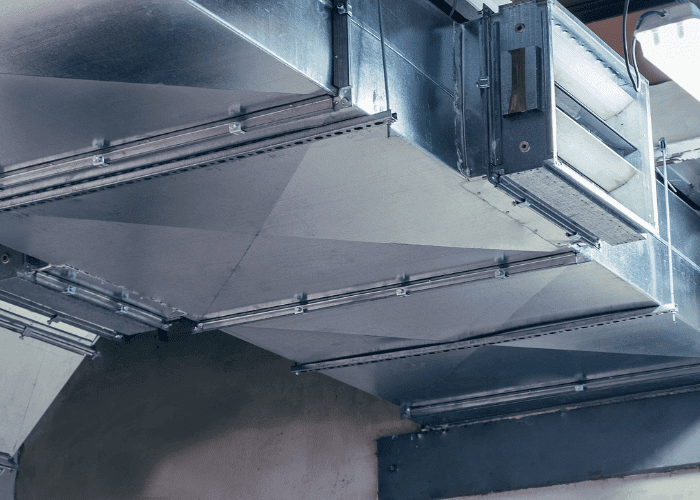Avoid These Ductwork Design Mistakes to Improve A/C
By My Service Depot on Monday, September 26, 2022Improve the efficiency and quality of air in your HVAC system by following these simple tips on how to avoid common ductwork mistakes.
It’s no secret that ductwork is a critical part of any air conditioning system. Poorly designed or installed ductwork can lead to all sorts of problems, including decreased cooling efficiency and even structural damage. So if you’re planning on installing or upgrading your AC system, be sure to avoid these common ductwork design mistakes.
The Importance of Good Ductwork Design

The ductwork in a home is responsible for delivering conditioned air from the HVAC system to the various rooms in the house. To function properly, ductwork must be designed and installed using strict guidelines. Unfortunately, many homes have poorly designed ductwork that leads to several problems, including poor indoor air quality, high energy bills, and inconsistent temperatures.
A good ductwork design takes into account the size and layout of the home, as well as the location of the HVAC system. It also ensures that all air vents are properly sized and placed to provide optimal airflow. By investing in good ductwork design, homeowners can enjoy greater comfort and lower utility costs.
The design of a home’s ductwork is important for several reasons. First, a good ductwork design can help to improve the efficiency of the heating and cooling system. By making sure that the ducts are the right size and placed in the most efficient route, less energy is required to heat or cool the air as it travels through the system.
In addition, good ductwork design can also help to improve indoor air quality. By ensuring that the ducts are well-sealed and free of leaks, you can help to prevent dust, pollen, and other allergens from entering the home. As a result, good ductwork design is essential for both comfort and indoor air quality.
5 Poor Ductwork Mistakes to Avoid

Ductwork is an essential part of any HVAC system. Properly designed and installed ductwork ensures that heated or cooled air is delivered to the rooms in a home or office as efficiently as possible. However, even a small mistake can have a big impact on its performance.
- One of the most common mistakes is failing to properly seal the ducts. This can lead to air leaks and loss of energy, as well as reduced indoor air quality.
- Another common mistake is using too small of a duct or underestimating the amount of airflow required. This can result in excessive noise and vibration, as well as decreased efficiency.
- If your ductwork is not properly insulated, it can cause the air temperature to fluctuate, resulting in hot or cold spots. Another cause of hot and cold spots are leaks in the ductwork. If air is leaking out of the ducts, it can cause the temperature in the room to drop. If the leaks are large enough, they can also cause the air conditioner to overwork and eventually break down.
- Another factor that is commonly ignored is using excessively long runs of ductwork. This can create a pressure drop that reduces airflow and makes the system less efficient.
- Finally, poor ductwork is often positioned in locations where it is likely to be blocked by furniture or other objects. This can reduce airflow and make it more difficult to maintain comfortable temperatures throughout the home.
There are still many other decisions will affect your air conditioning system, such as choosing the right materials for your ductwork. Depending on the application, different materials will have different strengths and weaknesses. For example, metal ductwork is very durable but can be difficult to install, while flexible ductwork is easier to install but may not be as durable. Choosing the wrong material can lead to problems such as leaks, breaks, or even fire hazards.
With so many potential pitfalls, it’s important to work with a qualified contractor who has experience with ductwork installation. By avoiding these mistakes and choosing the right options for your air conditioning system, you can ensure that your ductwork will provide years of trouble-free operation.
Consequences of Poor Duct Work

One of the most common issues with poor ductwork are air leaks. When air leaks out of the ductwork, it not only lowers the efficiency of the HVAC system but also raises your energy bills.
Air leaks can allow dust and pollutants to enter your home, which can trigger allergies or respiratory problems. Another consequence of poor ductwork is that it can cause your HVAC system to work harder than necessary. This not only puts additional wear and tear on the system but also uses more energy, further increasing your bills.
In extreme cases, poorly maintained ductwork can even cause your HVAC system to overheat and initiate a fire. To avoid these consequences, it is important to have your ductwork regularly inspected and cleaned by a professional.
Poorly designed and installed ductwork is also one of the leading causes of energy loss in buildings. It’s estimated that ductwork can account for up to 30% of a building’s heating and cooling costs.
There are several ways to improve the efficiency of ductwork, including proper sizing, sealing leaks, and insulating exposed ductwork. By taking these steps, building owners can significantly reduce their energy costs and improve the comfort of their tenants.
How to Make Sure You Have Good Ductwork Design
When it comes to ductwork, the design is just as important as the installation. To avoid the common issues listed above, it is important to work with a qualified contractor who has experience designing and installing ductwork.
- The first step in ensuring good ductwork design is to choose the right size for your ducts. This will ensure that they can deliver the correct amount of airflow to each room.
- Make sure that the contractor maps out the system according to your home so that it can be placed in a useful location and not around any potential obstacles that could block or restrict airflow.
- Another important aspect of good ductwork design is proper insulation and sealing. This will help to keep the air temperature consistent and prevent hot or cold spots.
- Finally, the contractor should use quality materials that are appropriate for the application.
By following these guidelines, you can be sure that your ductwork will be designed and installed correctly, resulting in years of trouble-free operation.
How to Get the Most out of Your Air Conditioner
Air conditioners are a great way to keep your home cool and comfortable during the hot summer months. However, they can also be a major source of energy consumption. To get the most out of your air conditioner, it is important to keep it properly maintained and use it wisely. Here are some tips:
Keep the Filters Clean or Replace Them
Dirty filters reduce airflow and make the unit work harder, which uses more energy and drives up your utility bills. Clean or replace the filters once a month during the summer to keep your air conditioner running efficiently.
Don’t Set the Temperature Too Low
Every degree below 78 degrees Fahrenheit can add 3-5% to your energy bill, so it’s important to find a balance between comfort and cost. When you’re home, set the temperature as high as you can tolerate, and use fans to circulate the cool air. When you’re away from home, set the temperature no lower than 78 degrees to prevent your energy bills from soaring.
Use Shade Wisely
Shade from trees and other structures can help keep your home cooler, so during the cooler hours of the day, open the windows and turn off the air conditioner when there’s a breeze blowing through shady areas. Curtains or blinds can also help keep rooms cool by blocking direct sunlight. This will help to cool down your home and reduce the need for artificial cooling.
Keep the Area Around Your Air Conditioner Free of Clutter
Blocking the airflow will make the unit work less efficiently. Make sure there are at least two feet of clear space around the unit for proper airflow. This will help to keep your air conditioner running efficiently and prevent it from overworking.
Use a Programmable Thermostat
This will allow you to set different temperatures for different times of the day, so you’re not cooling an empty house when you’re away at work or school. A programmable thermostat can save you up to 10% on your energy bill, so it’s a great way to reduce your carbon footprint and save money.
Regularly Service Your System
Like any other home appliance, your air conditioner needs regular maintenance to run efficiently. Schedule a tune-up at the beginning of the cooling season to ensure everything is clean and in good working order. This will help to extend the life of your unit and prevent costly repairs down the road.
Air conditioners are a necessary part of summertime comfort, but it’s important to use them wisely to avoid energy waste and high utility bills. With a little bit of care and attention, you can keep your air conditioner running efficiently all season long.
Hire a Professional Contractor

Unfortunately, many homeowners make the mistake of assuming that all ductwork is essentially the same. As a result, they may try to save money by performing the installation themselves or hiring a less-experienced contractor. However, this often leads to subpar results.
One of the best ways to ensure good ductwork design is to hire a professional contractor. A professional contractor will have the experience and knowledge necessary to design a ductwork system that meets your specific needs. They will also be able to properly install the ductwork, ensuring that it functions correctly and delivers the correct amount of air to each room in your home.
In addition, a professional contractor will be able to offer advice on how to maintain your ductwork system, ensuring that it continues to function properly for years to come. By hiring a professional contractor, you can be confident that your ductwork system will be designed and installed correctly, providing you with optimal comfort and efficiency.
Make Sure They Meet the Criteria
When you are hiring a contractor to perform work on your home, it is important to verify that they are licensed and insured. A license indicates that the contractor has met the requirements for performing work in your state or locality. Insurance protects you from financial liability if the contractor damages your property or hurts themselves while working on your behalf.
To verify a contractor’s licensing and insurance status, you can contact your state’s licensing board or the contractor’s insurance company. By taking these simple steps, you can protect yourself from costly repairs or legal action.
Conclusion
We hope this article has helped you understand the importance of good ductwork design and some of the consequences of poor ductwork. It is essential to have a good ductwork design to ensure your home is comfortable and your air conditioner is running as efficiently as possible. The best way to ensure quality work is done is by hiring a professional contractor.
Sometimes though, even the professionals need help. That is where Smart Service software designed for the field service industry comes in. This industry leading field service management software streamlines everyday work processes like scheduling, routing, and dispatching.
If you are already using Quickbooks scheduling software, even better! Smart Service integrates seamlessly with Quickbooks allowing you to use the data already on your system. This allows for less time with double data entry and more time focusing on what matters, YOUR CUSTOMERS! Stay competitive in a very fast growing industry and try a free HVAC software demo today!


